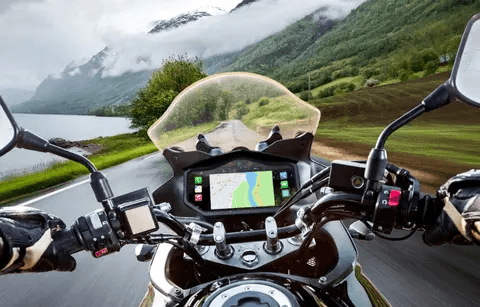Although countless articles about the future of transportation focus on four-wheeled electric vehicles, more and more mobility rely more heavily on economical two-wheeled electric vehicles, including scooters, heavy motorcycles, electric motorcycles, e-mopeds, and e-bikes. These two-wheeled electric vehicles are following the design trends of four-wheeled electric vehicles by incorporating touchscreens for control, replacing physical knobs, buttons, and mechanical dials.
The adoption of touchscreens enables designers of two-wheeled electric vehicles to create models with a modern appearance, flexible layouts, and stylish designs. It also allows for easy customization according to different models or even individual vehicles. User-friendly menu systems can meet the more complex control, display, and functionality requirements of two-wheeled electric vehicles while also enabling value-added features such as navigation, infotainment systems, remote payments, and vehicle security.
The touchscreens on two-wheeled electric vehicles are often exposed to harsh outdoor environments, making them vulnerable to rain, snow, dust, or sand. In hot climates, these vehicles may sometimes be parked under direct sunlight, subjected to intense UV and infrared radiation. Additionally, they are prone to accidents or deliberate damage.
Considering these factors, touchscreens for two-wheeled electric vehicles should ideally have an IP65/68 protection rating and thick cover glass to safeguard the underlying touch sensors and LCD or OLED display components. To prevent damage from sunlight and UV radiation, UV/IR filters are required, and anti-reflective/anti-glare coatings should be applied to enhance screen visibility under all lighting conditions.
Consequently, the display stack needs a thick, multi-layered design. However, each additional layer increases the distance between the finger and the capacitive touch sensor, making it more challenging to accurately detect touch inputs on the screen surface.
In cold regions, touchscreens are often operated by riders wearing thick gloves, which further increases the distance between the fingers and the touch sensor. Additionally, rain or snow on the screen in wet weather can lead to false touches or missed inputs.
A high-quality touchscreen must not only reliably track the path of a finger moving across the screen but also accurately detect multi-finger gestures made with thick gloves in wet conditions, enabling functions like navigation on maps. Touchscreens need to meet a wide range of environmental demands, placing stringent requirements on the touchscreen controller IC, which must address the following design challenges:

Thicker Display Stacks
Touchscreen controllers must support significant flexibility to accommodate various layers above the touch sensor in the display stack. Advanced technology with an equivalent thickness of 10 mm or more is required, enabling the use of anti-reflective and anti-glare coatings, along with 4 mm thick cover glass and operation with 3 mm thick gloves. Alternatively, touchscreen designers may include an air gap between the screen and glass, allowing the top glass layer to be replaced without swapping the entire display in case of damage. However, the increased thickness makes it more challenging for the touchscreen controller to accurately detect and decode touch inputs. Controllers must rise to this challenge.
Reliable Touch Performance
Two-wheeled electric vehicles are typically used outdoors for most of their lifespan. Touchscreen controller algorithms must prevent water droplets from being misinterpreted as touches, detecting only inputs from fingers or gloved hands. Capacitive sensing must also distinguish between conductive cleaning solutions (like bleach) and their mixtures with water, ensuring no false touches occur.
Functional Safety
Two-wheeled electric vehicles worldwide require functional safety features to protect riders while using the touchscreen. Features like navigation and hands-free calls during riding could pose distractions. Screens may need to comply with safety standards such as ISO 26262 (ASIL-B). Controllers must provide self-testing functions, documentation, and guidelines to support certification.
Security
In rental scenarios, touchscreens may be used to input PINs, granting vehicle access to renters. They also support contactless payments via credit cards or smartphones. Touchscreen controllers must include encryption and firmware authentication to ensure data privacy.
Noise Immunity
Powertrain circuits that drive electric motors generate radiated and conducted electromagnetic noise. Switching power supply-based chargers introduce noise into vehicle power lines, and lighting systems may cause conducted noise. Even LCD or OLED panels can emit electromagnetic interference. Without proper noise control, these sources can degrade touchscreen functionality. Controllers must include noise filtering algorithms to avoid false activations, especially during operation.
Microchip’s maXTouch® Touchscreen Controllers
Microchip’s maXTouch® series is equipped with features to meet these stringent requirements and enhance the touchscreen experience. Key capabilities include:
- Support for screens from 2 to 34 inches with various aspect ratios.
- Compatibility with thick cover glass up to 10 mm and air gaps of 0.2 mm or more.
- Accurate touch detection through 5 mm thick gloves (e.g., ski or motorcycle gloves).
- Moisture resistance, preventing false touches caused by water droplets, flows, 3.5% saline, or cleaning solutions.
- Encrypted messages and hidden PIN configurations.
- Interoperability with NFC( Near Field Communication) technology.
- High conducted noise immunity (certified to Class A IEC 61000-4-6).
- Self-diagnostic and reporting functionality.
- Support for Linux®/Android™ operating systems.
Conclusion
Two-wheeled electric vehicle designs are complex, much like four-wheeled vehicles. Designers continuously add new features to meet evolving consumer expectations. Enhanced touchscreens, supported by capable touchscreen controllers, offer the flexibility required to integrate these features into vehicle designs. By addressing unique requirements and carefully selecting touchscreen controllers, the demands of two-wheeled electric vehicle designs can be effectively met.



